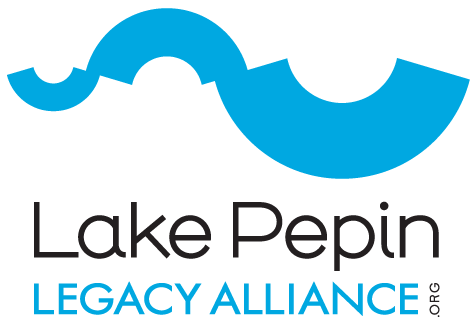By Anne Queenan
As the towboats and barges make their way back up the Mississippi River, the 2017 season of commercial navigation begins. In addition to the usual navigational and dredging activities related to keeping the nine foot wide channel open, this season on Lake Pepin, the U.S. Army Corps of Engineers will begin studying closely how and if there's a beneficial use of the sand and sediment it has been dredging and storing - one that would actually help the habitat and water quality at the upper end of the lake. Possibilities under consideration include: dredging backwaters to increase the depths needed for overwintering fish; constructing islands and land extensions for increased vegetation and diversified habitat - under the water, and on the islands themselves.
Read MoreBy Emily Green
LPLA obtained funding from the McKnight Foundation to support research designed to develop a methodology for identifying and prioritizing critically erosive ravine and bluff sites within the Blue Earth (BERB) and Le Sueur River Basins (LSRB). The research was conducted by graduate student Anna Tran, under the supervision of Professor Shannnon Fisher of Minnesota State University Mankato, former Director of the MSU Water Resources Center.
Read MoreBy Anne Queenan
Leon Morrison is a member of LPLA and the 2014 Conservation Farmer of the Year recipient in Pierce County. Today, he takes great measures to see that his topsoil stays put and does not eventually end up in Lake Pepin through practicing No-Till farming.
“We need to keep the soil up here, on the hills,” he said. The topsoil has the most organic matter. When the organic matter in the top soil is lost, says Morrison, it exposes the soil with extremely poor infiltration which erodes easily. “You don’t need topsoil in Lake Pepin.”
“We gotta get more incentives for no-till farming,” he said.
Read MoreBy Anne Queenan
Fifty citizens of the Lake Pepin area came to Stockholm, Wisconsin to learn more about Lake Pepin Legacy Alliance, the current conditions of the lake and possible solutions at the WideSpot Performing Arts Center in September. Some of these Wisconsin residents have seen results from their advocacy efforts in earlier years which helped bring about tighter regulation on point source pollution (phosphorous) from wastewater treatment plants and infrastructure upstream in Minnesota. They have had a big, positive impact. However, the lake remains impaired because we have not been successful at addressing our non-point source of pollutants.
Resdents came to learn more from a Senior Scientist at the St. Croix Watershed Research Station, Shawn Schottler. Schottler evaluates land management strategies to inform agencies, legislators, non-profits and producer groups in Minnesota based on research on the impaired conditions of our waters.
Lake Pepin Legacy Alliance invited him to hear how things are looking for Lake Pepin.
Read MoreBy Anne Queenan
"I only became a photographer because I am here,” said Meixner. As the artist describes daily life in the river’s ecosystem, one appreciates how it is teeming with fish, fauna and flora, all impacted by the shallow and turbid waters.
There's the species who spawn in the backwaters but need deeper water to overwinter - crappies, large-mouth bass and bluegills. There's the morning's visitors: a white-tailed deer, and a snapping turtle scoping out a spot in his sanctuary to lay her eggs - and the nearby call of two pileated woodpeckers.
“We’re going to lose it all, if we don’t address the sediment and erosion issues on this lake, ” said Meixner.
Read MoreBy Mike McKay
“Really, what we do as farmers is harvest the sun,” said Bruce Tiffany, who raises corn and soybeans near Redwood Falls in southwestern Minnesota.
The Mississippi River also “harvests the sun.” Unfortunately, excessive suspended sediment, mostly from the Minnesota River, keeps the river so cloudy that little sunlight reaches the river bed to stimulate growth of wild celery, sago pondweed, star grass and other desirable species of “submerged aquatic vegetation.”
So, at a vital, fundamental level, we residents of the Lake Pepin area share a common interest with Minnesota River basin farmers in optimizing the harvesting of the sun.
Read More“I look back at what the Mississippi is to me, and it’s the giver of life. Everything is a circle — a circle of life. That river’s been around here for thousands of years, and people have been using it for thousands of years. And people will continue to use it for the next thousands of years. As long as we keep that circle, don’t try to sever all the spines that go to it, because the Mississippi is just one part of that web.”– Jim Jones, Jr., Bemidji, MN
Read More